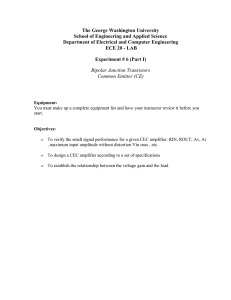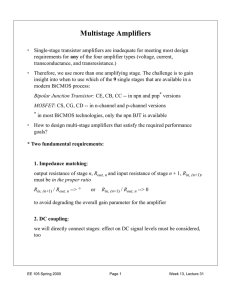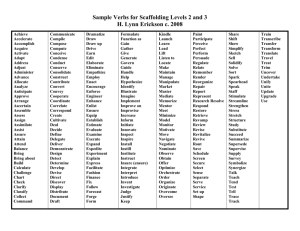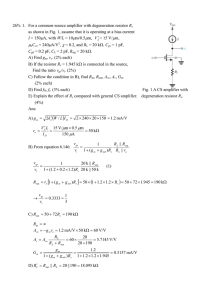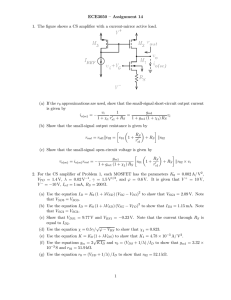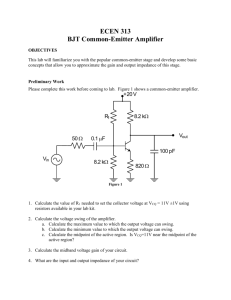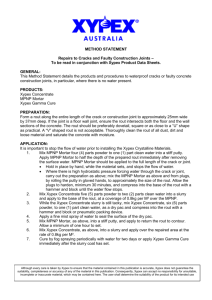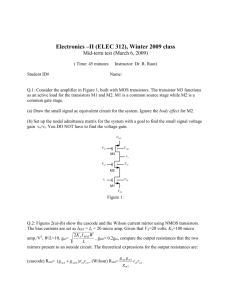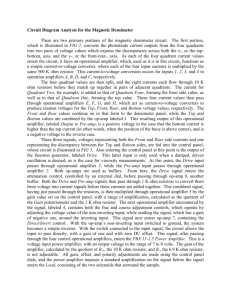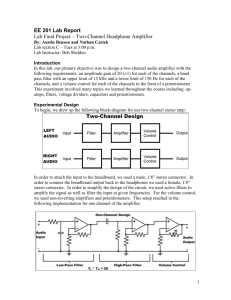Physics 123: Homework 1, Passive Devices Contents
advertisement
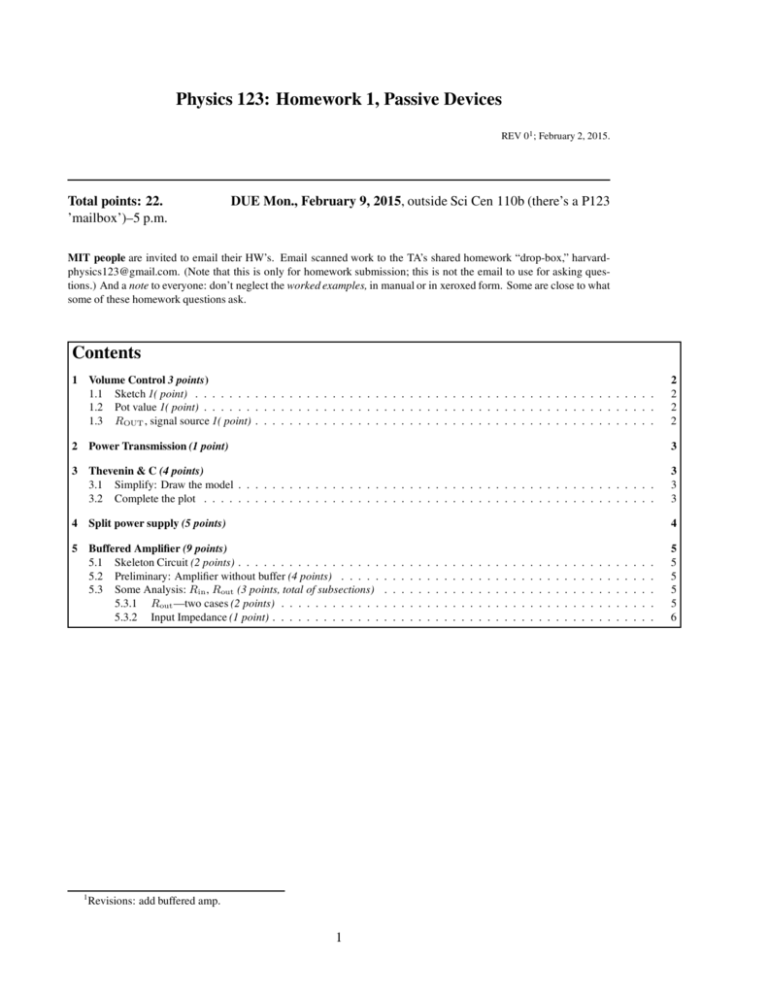
Physics 123: Homework 1, Passive Devices REV 01 ; February 2, 2015. Total points: 22. ’mailbox’)–5 p.m. DUE Mon., February 9, 2015, outside Sci Cen 110b (there’s a P123 MIT people are invited to email their HW’s. Email scanned work to the TA’s shared homework “drop-box,” harvardphysics123@gmail.com. (Note that this is only for homework submission; this is not the email to use for asking questions.) And a note to everyone: don’t neglect the worked examples, in manual or in xeroxed form. Some are close to what some of these homework questions ask. Contents 1 Volume Control 3 points) 1.1 Sketch 1( point) . . . . . . . . . . . . . . . . . . . . . . . . . . . . . . . . . . . . . . . . . . . . . . . . . . . . . . 1.2 Pot value 1( point) . . . . . . . . . . . . . . . . . . . . . . . . . . . . . . . . . . . . . . . . . . . . . . . . . . . . . 1.3 ROUT , signal source 1( point) . . . . . . . . . . . . . . . . . . . . . . . . . . . . . . . . . . . . . . . . . . . . . . . 2 2 2 2 2 Power Transmission (1 point) 3 3 Thevenin & C (4 points) 3.1 Simplify: Draw the model . . . . . . . . . . . . . . . . . . . . . . . . . . . . . . . . . . . . . . . . . . . . . . . . . 3.2 Complete the plot . . . . . . . . . . . . . . . . . . . . . . . . . . . . . . . . . . . . . . . . . . . . . . . . . . . . . 3 3 3 4 Split power supply (5 points) 4 5 Buffered Amplifier (9 points) 5.1 Skeleton Circuit (2 points) . . . . . . . . . . . . . . . . . 5.2 Preliminary: Amplifier without buffer (4 points) . . . . . 5.3 Some Analysis: Rin , Rout (3 points, total of subsections) 5.3.1 Rout —two cases (2 points) . . . . . . . . . . . . 5.3.2 Input Impedance (1 point) . . . . . . . . . . . . . 1 Revisions: add buffered amp. 1 . . . . . . . . . . . . . . . . . . . . . . . . . . . . . . . . . . . . . . . . . . . . . . . . . . . . . . . . . . . . . . . . . . . . . . . . . . . . . . . . . . . . . . . . . . . . . . . . . . . . . . . . . . . . . . . . . . . . . . . . . . . . . . . . . . . . . . . . . . . . . . . . . . . . . . . . . . . . . . . . 5 5 5 5 5 6 1 Volume Control 3 points) We’d like you to show how to use a potentiometer to adjust the amplitude of a signal sent to a “load,” which might be (for example) an audio amplifier. If it were such an amp, we could call this thing you’re designing a “volume control.” Here’s the signal source and load. We’d like you to install the missing link. Your volume control should operate as advertised—“5” should be half volume, etc.2 That means “don’t let it interact with load or source.” Figure 1: Signal source and load; you are to design the missing link 1.1 Sketch 1( point) Draw in the missing component, allowing adjustment of amplitude from zero to full amplitude. Arrange things so that your component does not mess up the signal source appreciably (by house standards, that means ‘don’t let your component cause more than 10% “droop”’). 1.2 Pot value 1( point) Specify the max or min value for the resistance of this component (and tell us which you intend). Again, we don’t want the ‘load’ to cause more than 10% attenuation in the output of your circuit. Explain your choice, very briefly. 1.3 ROUT , signal source 1( point) Specify the max or min value for ROUT for the signal source that drives your volume control (in case the term “ROUT ” puzzles you, “ROUT ” is exactly equivalent to RThevenin for the signal source). Explain your choice, very briefly. 2 If you are very bold—and are familiar with the movie, “This Is Spinal Tap”—you may want to take the full volume all the way to eleven. 2 2 Power Transmission (1 point) If the power utility in Cambridge sent power about the city at 100V rather than at 20,000V, by what factor would power losses grow? If an electric stove were powered at 120V rather than at 240V, by what factor would power losses in its house wiring grow? RC applications 3 3.1 Thevenin & C (4 points) Simplify: Draw the model Start by simplifying the circuits shown below, into a single Thevenin model driving a single C, after the switch is closed. Figure 2: Thevenin and RC: circuits to be simplified 3.2 Complete the plot Then complete the plot, showing voltages and the RC time-constant, with its value indicated. 3 4 Split power supply (5 points) Show a design for a “split” power supply, to put out both positive and negative voltages, simultaneously, from a single transformer. Here are the specifications: Vin 60Hz, 115VAC (rms) Vout +17V and -17V (minimum amplitudes)a ripple about 1.5V load current 1A a You may be inclined to protest that these are crazy and arbitrary numbers. In fact, they’re not: a typical voltage regulator IC, a device that stabilizes its output at a given voltage, needs a couple of volts difference between input and output (this is called its ”dropout voltage”). So, to get ±15V regulated outputs, you need at least ±17V inputs. DRAW the supply. Here’s what we’d like you to specify: • transformer secondary voltage (rms) Assume that you are to use a center-tapped transformer, and that the following voltages are available (rms): 10, 12.6, 14, 18, 24, 26.8, 35, all center-tapped; between center-tap and either end of the winding you see half the rated voltage, as you probably know. • transformer current rating • filter capacitors • fuse value (primary side, as you know). EXPLAIN your choice of value. 4 5 Buffered Amplifier (9 points) We’d like you to design a circuit in stages. It’s to be an amplifier, with pretty good Rout . 5.1 Skeleton Circuit (2 points) This is the part of the problem that is most fundamental—but probably not difficult: sketch a circuit omitting component values. Here are its sketchy specifications: • single supply • modest voltage gain • pretty-good Rout , improved by the presence of an emitter follower 5.2 Preliminary: Amplifier without buffer (4 points) Now let’s plug in component values for the amplifier. This task is fussier, and here are the specifications: • • • • 5.3 power supply voltage: +30V quiescent current in gain stage: 1mA gain: -10 (the minus only means ‘circuit inverts signal’) signal frequencies: 100Hz and up Some Analysis: Rin, Rout (3 points, total of subsections) 5.3.1 Rout—two cases (2 points) . . . no follower What would be the amplifier’s Rout if output were taken at the collector of the first transistor (that is, as if no follower were included in the design)? . . . assuming follower is included What is the amplifier’s Rout taken at the output follower that we hope you included? 5 5.3.2 Input Impedance (1 point) We are calling this property Zin , because strictly this value does vary with frequency. The impedance that interests us, however, is the one that applies at what we call “signal frequencies.” At those frequencies, we treat the blocking capacitor that we’re confident you included as a short circuit, and the input impedance in this range does not vary with frequency. That simplifies the analysis, and makes it more useful than if you were to give a complicated frequency-dependent answer. (hw1 spring2015.tex; February 2, 2015) 6
